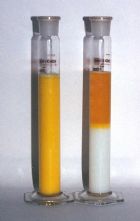When water and oil are mixed together and vigorously shaken, a dispersion of oil droplets in water - and vice versa - is formed. When shaking stops, the phases start to separate. However, when an emulsifier is added to the system, the droplets remain dispersed, and a stable emulsion is obtained.
An emulsifier consists of a water-loving hydrophilic head and an oil-loving hydrophobic tail. The hydrophilic head is directed to the aqueous phase and the hydrophobic tail to the oil phase (see figure 1). The emulsifier positions itself at the oil/water or air/water interface and, by reducing the surface tension, has a stabilising effect on the emulsion.

The tube on the left contains an emulsion. The two separated layers are shown on the right.
In addition to their ability to form an emulsion, emulsifiers have the ability to interact with other food ingredients. In this way, various functionalities can be obtained, for example interaction with proteins or carbohydrates. The emulsifier may be an aerating agent, starch complexing agent and/or crystallisation inhibitor (read more in applications).